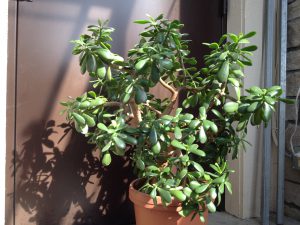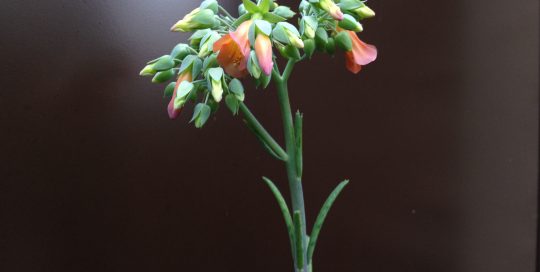Jade Plants
Views: 8119

Jade plants, or Crassula ovata, have always seemed sort of mysterious and important to me, but I’m not sure why. Maybe it’s because it seems like some sort of meaningful ancient plant? Maybe it’s because it naturally takes on the appearance of a bonsai tree as it ages? Or maybe it’s just that it’s named after a valuable mineral. It’s other common names are money plant, friendship plant, and lucky plant. These give it a greater sense of importance than other houseplants with common names like dumb cane, snake plant, or Christmas cactus.
Regardless of the reason, I have always held Jade plants above most other houseplants and freak out in a really plant-nerdy kind of way when I see a large, old specimen.
Caring for jade plants
These long-lived succulents are really very easy to care for. According to Chinese folklore, will bring prosperity into your life if you base the placement in your home on Feng Shui principles*. However, it’s a little silly that the jade plant is associated so strongly with Chinese culture since it is native to South Africa and Mozambique, not East Asia. At some point in history, this succulent became permanently embedded in Asian lore. It remains a popular houseplant and symbol of good luck around the world.
Jade plants are pretty adaptable to various light conditions. In full sun, the leaves may flush a rosy pink around the edges. This is fine, but if the whole leaf flushes or brown patches appear, it may be getting sunburned. It should be moved to a location with less intense light. If the plant isn’t getting enough light, the leaves will be spaced further apart. This makes it appear like it is stretching for light. In this case, it should be moved to a brighter location. Basically any light conditions between the extremes of full sun and full shade should be agreeable with the jade plant.
Ideal conditions
Overwatering is probably the most common issue people have with jade plants (and all succulents for that matter). Plants with fleshy leaves use them to store water and therefore require less water in general. It is important to let succulents dry out in between watering. Stick your finger in the soil before watering and only water if it feels bone dry. Also, the leaves will take on a slightly shriveled look when the plant needs water, but if the leaves are turning yellow and falling off, it is likely that the plant is being overwatered.
Jade plants don’t require a lot of soil to thrive and do well in shallow containers. For larger plants, be sure to use heavy containers since jade plants tend to be top heavy. Drainage holes are crucial for these and all other container-grown succulents. They only need to be repotted every few years and are easily propagated from leaf and stem cuttings. Just let the cutting dry out for a few days and then insert the bottom into fresh, barely moist soil. Also, don’t be afraid to prune your jade plant, they will quickly push out new growth when a stem is cut back.
With proper care, jade plants can outlive their human owners and mature to the size of a small tree, so be prepared to have this plant for the long-haul. And who knows, maybe your luck will improve when you add one to your home!
*For those who believe, place your jade plant by the entry or in the southeast corner of your home or business to improve your luck and/or financial situation.
Meet Abbi Hayes
Abbi's Recent Posts

Kalanchoe delagoensis: Mother of Millions







